Three Free Men - Getty Images on Lockdown
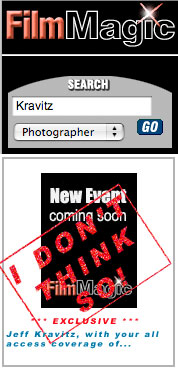 The story first broke on Paul Melcher's blog, where Paul reported:
The story first broke on Paul Melcher's blog, where Paul reported:
"Jeff Kravitz, President and Founder of Filmmagic, bought by Getty Images in the $200 million Mediavast deal, has officially resigned. Citing impossible working conditions within the Mega image distributor, antiquated distribution system, one of the most succesful, and influential, red carpet photographer is slamming the door in the face of the Getty management."
So, we called Mr. Kravitz, who was on the East Coast covering an event, and I asked him about the above quote, and he said, without actually confirming he wrote that in an internal e-mail "well, that sounds like something I would say" and then said that "all I'll say is it's an interesting time in my life, and everyone should just stay tuned." Mysterious? Yes, Ambiguous? I think Kravitz is smart like a fox to have provided just the right answer. (Check Jeff's blog for some cool insights into his life, but nothing about this - yet, anyway.)
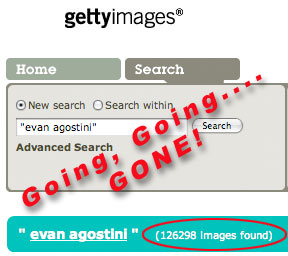 Also, the rumor that Evan Agostini (hit this link for a brief story and headshot of him) and Peter Kramer, both of them prolific photographers, having nearly 200,000 images they produced on the Getty Images site (and wholey owned by Getty, from what I understand), are leaving GYI for the Associated Press is true.
Also, the rumor that Evan Agostini (hit this link for a brief story and headshot of him) and Peter Kramer, both of them prolific photographers, having nearly 200,000 images they produced on the Getty Images site (and wholey owned by Getty, from what I understand), are leaving GYI for the Associated Press is true. 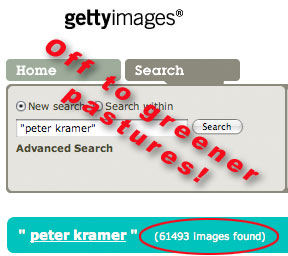 Well, I have it confirmed from a source inside Getty that they're leaving, but I don't have it confirmed that they're landing at the AP, but that would make a ton of sense for them, especially given the rumor that's floating around about an AP internal restructuring to throw more money at entertainment and sports (can you say, "shot across the bow of GYI?") in the near future, so as to beat down the getty inroads in those arenas of late.
Well, I have it confirmed from a source inside Getty that they're leaving, but I don't have it confirmed that they're landing at the AP, but that would make a ton of sense for them, especially given the rumor that's floating around about an AP internal restructuring to throw more money at entertainment and sports (can you say, "shot across the bow of GYI?") in the near future, so as to beat down the getty inroads in those arenas of late.That just leaves 12 (most likely) Angry Men left -stuck in Getty's quagmire, under NDA's and non-completes for probably 3-5 years, depending upon how the deal was handled. Kevin, Paul, Lester, Justin, Steve, Michael, Jeff, Jason, Josh, Stephen, Michael, and Mark - I wish you well, and I look forward you when you find yourself out of the labrynth of bureacracy and red tape and: A) depart, and B) finish up your non-competes while hanging out poolside. When you're free and clear, I know you'll all be back, and better than when you were under the Getty regime. By that time, GYI could well be a penny stock, or Google/Rupert Murdoch could have paid $10 a share to populate their respective photo services with great photos. Nice work on the $200 mil figure, you all look like geniuses, with JDK/et al as the happless dunces in the corner.
Please post your comments by clicking the link below. If you've got questions, please pose them in our Photo Business Forum Flickr Group Discussion Threads.
 Jonathan Klein, Getty Images Co-Founder and CEO said, during a
Jonathan Klein, Getty Images Co-Founder and CEO said, during a  Today's Speedlinks are so cool that the top four are now daily visits for me!
Today's Speedlinks are so cool that the top four are now daily visits for me! This past weekend, PhotoShelter launched what I consider the final phase of their marketplace entry, launching the PhotoShelter Collection. Daryl Lang, over at PDN penned their first review
This past weekend, PhotoShelter launched what I consider the final phase of their marketplace entry, launching the PhotoShelter Collection. Daryl Lang, over at PDN penned their first review  Betsy Reid caught me at a good time. I had just wrapped up phase 1 of my 19 hours in Atlanta at the PhotoShelter Town Hall, and as I was running out the door to present at the ASMP meeting, she thrust in my hand the SAA white paper, titled
Betsy Reid caught me at a good time. I had just wrapped up phase 1 of my 19 hours in Atlanta at the PhotoShelter Town Hall, and as I was running out the door to present at the ASMP meeting, she thrust in my hand the SAA white paper, titled 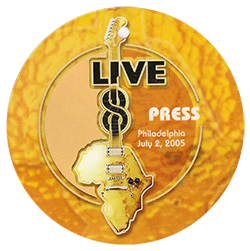 I recieved my September issue of Professional Photographer magazine this weekend that contained an article by
I recieved my September issue of Professional Photographer magazine this weekend that contained an article by 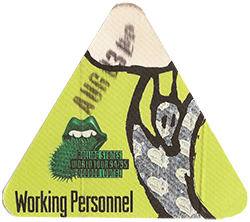 When you're in the pit, unless you have a pass like the one to the left or right, you'll get the boot after a very short period of time. For a Neil Diamond concert some years ago, it was 90 seconds, for recent Beyonce concerts, it can be as short as 50 seconds. Many times, it's first song, or first three songs. The truth is - if you are a professional, and you know what you are doing, you can accomplish your assignment needs within that period of time.
When you're in the pit, unless you have a pass like the one to the left or right, you'll get the boot after a very short period of time. For a Neil Diamond concert some years ago, it was 90 seconds, for recent Beyonce concerts, it can be as short as 50 seconds. Many times, it's first song, or first three songs. The truth is - if you are a professional, and you know what you are doing, you can accomplish your assignment needs within that period of time. 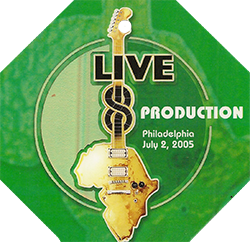 Further, the artist will look their best at the beginning of the show, when they've not perspired through their wardrobe. And two last points worth making - 1) the artist knows the press will be there, and is usually performing to appeal to their visual needs, and 2) the lighting is often brighter at that time because they know the press needs decent lighting to capture the artist at their best.
Further, the artist will look their best at the beginning of the show, when they've not perspired through their wardrobe. And two last points worth making - 1) the artist knows the press will be there, and is usually performing to appeal to their visual needs, and 2) the lighting is often brighter at that time because they know the press needs decent lighting to capture the artist at their best. None of this though, gets to the point about concert releases, but, is rather just a primer. To the left is one from a concert I did several years ago, but the language hasn't changed much on the photo release, as seen below.
None of this though, gets to the point about concert releases, but, is rather just a primer. To the left is one from a concert I did several years ago, but the language hasn't changed much on the photo release, as seen below.
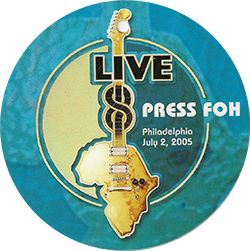 Aside from the "pit", or "buffer", mentioned in the
Aside from the "pit", or "buffer", mentioned in the 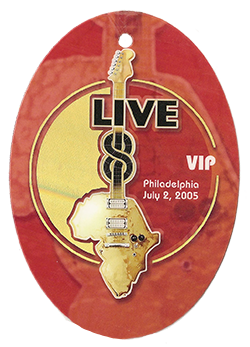 If you have a VIP credential (like the one at right), you're not a photographer, you don't have photo privledges, and more than likely, if you try to take pictures with just it on, those people with the big yellow "Event Staff" polo shirts will yank your camera away, unless, of course, you also are dating one of the band members.
If you have a VIP credential (like the one at right), you're not a photographer, you don't have photo privledges, and more than likely, if you try to take pictures with just it on, those people with the big yellow "Event Staff" polo shirts will yank your camera away, unless, of course, you also are dating one of the band members.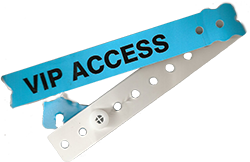 For bigger events, if you have a credential like above, or a wristband like on the left, you'll end up being able to get to the catered area backstage, meaning you won't starve.
For bigger events, if you have a credential like above, or a wristband like on the left, you'll end up being able to get to the catered area backstage, meaning you won't starve.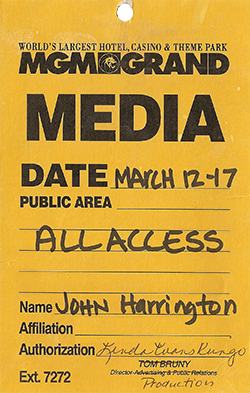 If you have an ALL ACCESS credential, you're in luck. Clearly, you know the band really well, you're working for whomever is bank-rolling the concert, you're the offical tour photographer, or the tour manager is your best friend. Either way, All Access isn't always "ALL ACCESS." Further, if you're only working at one of the concert tour stops, you'll not likely get one of these passes, because you don't really really need one. They're almost always given to the people that only really really need to have this level of access.
If you have an ALL ACCESS credential, you're in luck. Clearly, you know the band really well, you're working for whomever is bank-rolling the concert, you're the offical tour photographer, or the tour manager is your best friend. Either way, All Access isn't always "ALL ACCESS." Further, if you're only working at one of the concert tour stops, you'll not likely get one of these passes, because you don't really really need one. They're almost always given to the people that only really really need to have this level of access.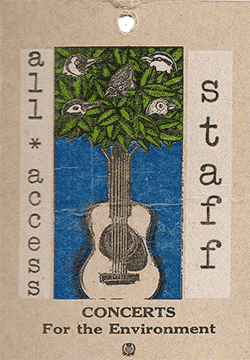 There are times when all access means "everywhere except the stage", or "everywhere except in the band's dressing room", or some variation thereof. A wristband is one of the ways that "non-performers" can get onto, or on the sides of the stage to make images. In addition to your All Access, or Production, pass, the wristband (just like the VIP wristband in that article) gets you to where you need. If you need to be on stage, then you'll likely also need a "Performer" or an "Artist" credential.
There are times when all access means "everywhere except the stage", or "everywhere except in the band's dressing room", or some variation thereof. A wristband is one of the ways that "non-performers" can get onto, or on the sides of the stage to make images. In addition to your All Access, or Production, pass, the wristband (just like the VIP wristband in that article) gets you to where you need. If you need to be on stage, then you'll likely also need a "Performer" or an "Artist" credential.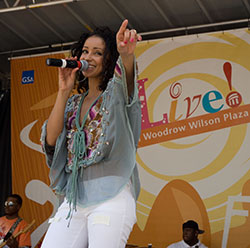 the first thing to do is, don't sign those contracts that limit what you can do with your images. Doing so will mean that you can't put them on your website to show you can shoot concerts, Don't trade the rights to your photos to be given to the artist for a press pass. This'll just make it that much harder for you to earn money when you do finally get into a rhythm of covering shows, because the bands will not only be of the mindset that photographers will do it, but in addition, others coming up behind you will think that that's the way to get a foot in the door. It's not.
the first thing to do is, don't sign those contracts that limit what you can do with your images. Doing so will mean that you can't put them on your website to show you can shoot concerts, Don't trade the rights to your photos to be given to the artist for a press pass. This'll just make it that much harder for you to earn money when you do finally get into a rhythm of covering shows, because the bands will not only be of the mindset that photographers will do it, but in addition, others coming up behind you will think that that's the way to get a foot in the door. It's not.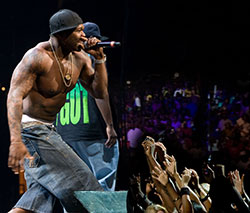 Summer festivals are chock full of GREAT artists at state fairs, outdoor performance theaters at amusement parks, beach concert series, and so forth. Local radio stations often sponsor local concerts in outdoor areas. In LA, there's Jimmy Kimmel's Pontiac Garage, in NYC, there's the NBC Outdoor Concert Series, and so forth. Go, make pictures, and practice. Take great pictures - ones that you own, and can offer to publications, or demonstate your capabilities on your website so concert-oriented publications will hire you. Further, there are a number of venues and artists where taking pictures is perfectly ok. One touring now is the hip-hop oriented Screamfest, (above left), where 50-cent was performing. For this image, I was wandering amongst the seats (i.e. not in the buffer), so this is an image that any ticketed attendee could have made. There are, of course many other concerts where you can do this.
Summer festivals are chock full of GREAT artists at state fairs, outdoor performance theaters at amusement parks, beach concert series, and so forth. Local radio stations often sponsor local concerts in outdoor areas. In LA, there's Jimmy Kimmel's Pontiac Garage, in NYC, there's the NBC Outdoor Concert Series, and so forth. Go, make pictures, and practice. Take great pictures - ones that you own, and can offer to publications, or demonstate your capabilities on your website so concert-oriented publications will hire you. Further, there are a number of venues and artists where taking pictures is perfectly ok. One touring now is the hip-hop oriented Screamfest, (above left), where 50-cent was performing. For this image, I was wandering amongst the seats (i.e. not in the buffer), so this is an image that any ticketed attendee could have made. There are, of course many other concerts where you can do this.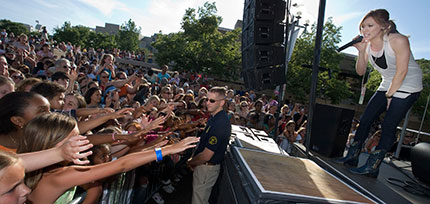
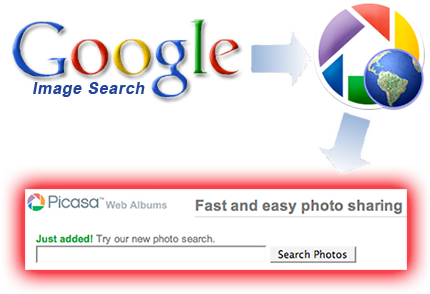
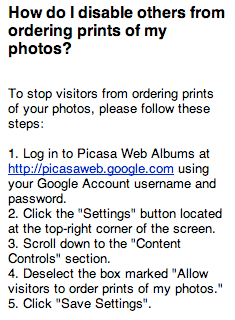 However, the default setting is for "public" on your images, and "download" and "allow prints" as well. How would you disable print for your photos? The language is pretty specific "Deselect the box marked 'allow visitors to order prints of my photos.'" When I uploaded an image, it was defaulted to be in a "public" album, and it was also defaulted to allow prints. In order words, I have to actually choose to preclude people from being able to order prints. Further, note the language above "just uncheck the public search option", meaning, again, it's defaulted to let the public search/view/download.
However, the default setting is for "public" on your images, and "download" and "allow prints" as well. How would you disable print for your photos? The language is pretty specific "Deselect the box marked 'allow visitors to order prints of my photos.'" When I uploaded an image, it was defaulted to be in a "public" album, and it was also defaulted to allow prints. In order words, I have to actually choose to preclude people from being able to order prints. Further, note the language above "just uncheck the public search option", meaning, again, it's defaulted to let the public search/view/download.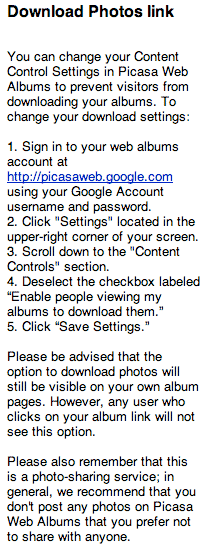 Same thing goes for permission to download. It starts off "You can change your Content Control Settings in Picassa Web Albums to prevent visitors from downloading your albums." It goes on to say "deselect the checkbox labeled 'enable people viewing my albums to download them.'" However, here's the rub, further down "Please also remember that this is a photo-sharing service; in general, we recommend that you don't post any photos on Picasa Web Albums that you prefer not to share with anyone." Oh, really? In other words, don't clog our servers with your own personal photos or photo archives. Only post photos that you want to give away for free to the 'community'?
Same thing goes for permission to download. It starts off "You can change your Content Control Settings in Picassa Web Albums to prevent visitors from downloading your albums." It goes on to say "deselect the checkbox labeled 'enable people viewing my albums to download them.'" However, here's the rub, further down "Please also remember that this is a photo-sharing service; in general, we recommend that you don't post any photos on Picasa Web Albums that you prefer not to share with anyone." Oh, really? In other words, don't clog our servers with your own personal photos or photo archives. Only post photos that you want to give away for free to the 'community'?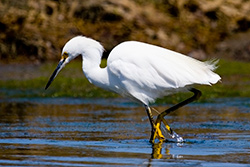 Ok, so, file not large enough? As I noted, it's up to the uploader. Photographer Mike Baird, who's caption of the photo to the left reads, in part "This Snowy Egret was shot at 1/4000th second, f 7.1, ISO 800 at 400mm...", which is a 300dpi file at 8" x 5.3". To download the full-rez file, click
Ok, so, file not large enough? As I noted, it's up to the uploader. Photographer Mike Baird, who's caption of the photo to the left reads, in part "This Snowy Egret was shot at 1/4000th second, f 7.1, ISO 800 at 400mm...", which is a 300dpi file at 8" x 5.3". To download the full-rez file, click 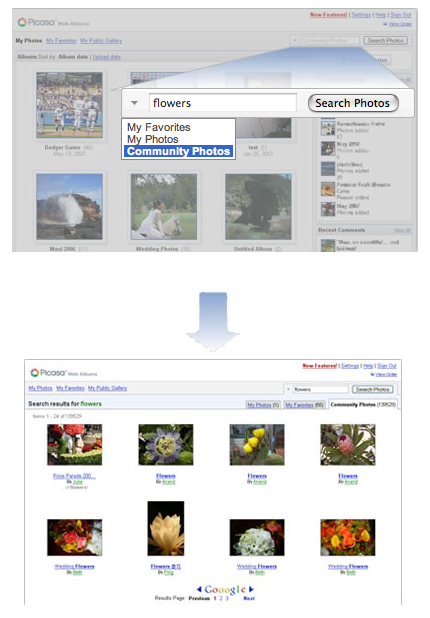
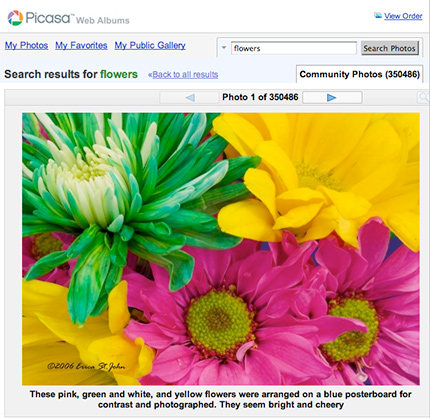
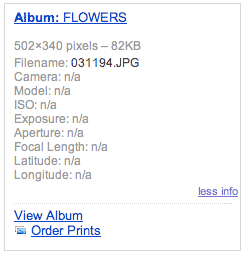 Here, to the left, you see the "more info" box, where you can choose "order prints". In the print dialog box, you then specify Shutterfly or Photoworks, and then the image is transfered to their site for printing. (this particular community member has turned off "download photos" for the photo above, this dialog box is adjacent to other images).
Here, to the left, you see the "more info" box, where you can choose "order prints". In the print dialog box, you then specify Shutterfly or Photoworks, and then the image is transfered to their site for printing. (this particular community member has turned off "download photos" for the photo above, this dialog box is adjacent to other images). 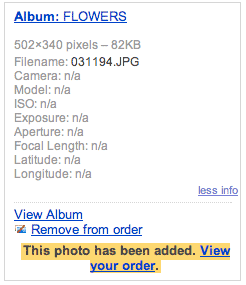 Here, below and to the right, you now see that the photo I've chosen has been added to my cart/order. I may now view my order, or keep browsing for other photographs that I'd like to have a print of.
Here, below and to the right, you now see that the photo I've chosen has been added to my cart/order. I may now view my order, or keep browsing for other photographs that I'd like to have a print of.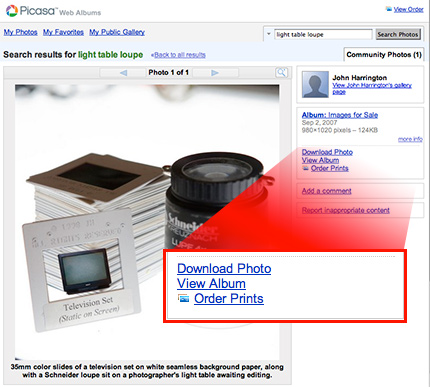
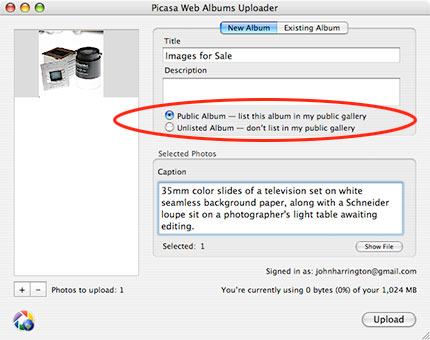
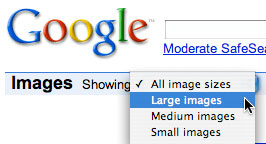 Google has also added (and this is within the last few days, as far as I can tell) a new "drop down menu" to their images.google.com search, as shown to the left. This "search by size" capability is something that Flickr does not currently have. In addition, it would be most easy to add other choices, like "From Picasa", but for now, choosing "Large images", gives you, well, large images.
Google has also added (and this is within the last few days, as far as I can tell) a new "drop down menu" to their images.google.com search, as shown to the left. This "search by size" capability is something that Flickr does not currently have. In addition, it would be most easy to add other choices, like "From Picasa", but for now, choosing "Large images", gives you, well, large images.